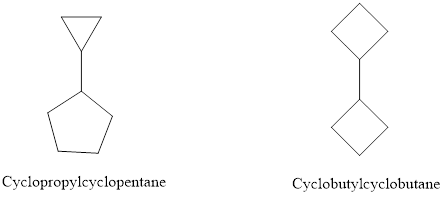
Concept explainers
(a)
Interpretation:The isomeric relationship between cyclopropylcyclopentane and cyclobutylcyclobutane should beidentified.
Concept introduction:Chiral carbon is any stereocenter attached to four different alkyl substituents. If any two of the substituent happen to be similar the center is regarded as achiral.
The enantiomers are identical chemical compounds that have a mirror-image relationship to each other while diastereomers do not hold similar mirror image relationships.
The molecular models of

The two compounds constitute a pair of constitutional isomers. These kinds of isomers are formed by cleavage and replacement of bonds, unlike the conformational isomers that result due to rotation around the bond.
(a)
Explanation of Solution
Structures of cyclopropylcyclopentane and cyclobutylcyclobutane are illustrated as follows:

The molecular formula for both cyclopropylcyclopentane and cyclobutylcyclobutane is
(b)
Interpretation: The isomeric relationship among
Concept introduction: Chiral carbon is any stereocenter attached to four different alkyl substituents. If any two of the substituent happen to be similar the center is regarded as achiral.
The enantiomers are identical chemical compounds that have a mirror-image relationship to each other while diastereomers do not hold similar mirror image relationships.
The molecular models of

The two compounds constitute a pair of constitutional isomers. These kinds of isomers are formed by cleavage and replacement of bonds, unlike the conformational isomers that result due to rotation around the bond.
(b)
Explanation of Solution
Structures of
are illustrated as follows:

Since cis and trans form represent diastereoisomers therefore
Want to see more full solutions like this?
Chapter 5 Solutions
Organic Chemistry: Structure and Function
- Draw structures for the following molecules. (a) 2-iodo-2,3-dimethylheptane (b) 4-cyclopropyl-3-ethyl-2-methyloctane (c) 1-ethyl-2,4-dimethylcyclopentanearrow_forwardDraw the structures of the following compounds. (a) 1-isobutyl-4-isopropylcyclohexane; (b) tert-butylcyclopentane;(c) 3,3-diisopropyloctanearrow_forwardDraw the structures for the following compounds.(a) 3-benzyl-4-bromohexane , 4,4-dimethylcyclohexene(b) trans-4,5-dibromohex-2-ene , cis-1,1-dibromo-2-ethyl-2,3-dimethylcyclobutanearrow_forward
- 2,3-Dibromoprop-1-ene (C3H4Br2) has four H atoms. Suppose that any of these H atoms can be replaced by a Cl atom to yield a molecule with the formula C3H3Br,Cl. (a) Identify two H atoms where this substitution would yield constitutional isomers of C3H3Br,CI; (b) enantiomers of C3H3Br,Cl; (c) diastereomers of C3H3Br,Cl. H нн H Br Br 2,3-Dibromoprop-1-enearrow_forwardButanal (C4H&O) has eight H atoms. Suppose that any of these H atoms can be replaced by a Cl atom to yield a molecule with the formula C4H¬CIO. (a) Identify two H atoms where this substitution would yield constitutional isomers of C4H7CIO; (b) enantiomers of C4H;CIO; (c) conformers of C4H;CIO. H. H H H нн H Butanal O=Uarrow_forwardDraw structures for the following haloalkanes. (a) 2,2-dichloro-3-cyclopropylbutane; (b) 1-bromo-1-chloro-1-iodobutane;(c) 2-bromo-1,1-diiodohexane; (d) 3-chloro-1,1,2,2-tetrafluoropentanearrow_forward
- The skeletal line formula for a branched alkene is shown below. (i) What is the molecular formula of this compound? (ii) How many carbon atoms are in the longest chain, ignoring the double bond? (iii) What is the longest chain incorporating both carbons of the double bond? (iv) How many substituents are on this chain? (v) Give the IUPAC name for this compound. [6]arrow_forwardDraw the structures for (a) 2-methyl-1,3,5-hexatriene and (b) 1,6-dimethoxyhexa-1,5-diene.arrow_forwardWrite structural formulas for compounds that meet the following descriptions:(a) An alkene, C6H12, that cannot have cis–trans isomersand whose longest chain is 5 carbons long(b) An alkene with a chemical formula of C10H12 that hascis–trans isomers and contains a benzene ring.arrow_forward
- Cyclopropane (C3H6, a three-membered ring) is more reactive than most other cycloalkanes.(a) Draw a Lewis structure for cyclopropane.(b) Compare the bond angles of the carbon atoms in cyclopropane with those in an acyclic (noncyclic) alkane.(c) Suggest why cyclopropane is so reactive.arrow_forwardThe meiting points and boiling points of two isomeric alkanes are as follows: CH3(CH2);CH3, mp = -57 °C and bp = 126 °C; (CHalsCC(CH3)3, mp = 102 °C and bp = 106 °C. (a) Explain why one isomer has a lower melting point but higher boiling point. (b) Explain why there is a small difference in the boiling points of the two compounds, but a huge difference in their melting points.arrow_forward(a) What is the molecular formula of hexane, the alkane withsix carbonsarrow_forward
 ChemistryChemistryISBN:9781305957404Author:Steven S. Zumdahl, Susan A. Zumdahl, Donald J. DeCostePublisher:Cengage Learning
ChemistryChemistryISBN:9781305957404Author:Steven S. Zumdahl, Susan A. Zumdahl, Donald J. DeCostePublisher:Cengage Learning ChemistryChemistryISBN:9781259911156Author:Raymond Chang Dr., Jason Overby ProfessorPublisher:McGraw-Hill Education
ChemistryChemistryISBN:9781259911156Author:Raymond Chang Dr., Jason Overby ProfessorPublisher:McGraw-Hill Education Principles of Instrumental AnalysisChemistryISBN:9781305577213Author:Douglas A. Skoog, F. James Holler, Stanley R. CrouchPublisher:Cengage Learning
Principles of Instrumental AnalysisChemistryISBN:9781305577213Author:Douglas A. Skoog, F. James Holler, Stanley R. CrouchPublisher:Cengage Learning Organic ChemistryChemistryISBN:9780078021558Author:Janice Gorzynski Smith Dr.Publisher:McGraw-Hill Education
Organic ChemistryChemistryISBN:9780078021558Author:Janice Gorzynski Smith Dr.Publisher:McGraw-Hill Education Chemistry: Principles and ReactionsChemistryISBN:9781305079373Author:William L. Masterton, Cecile N. HurleyPublisher:Cengage Learning
Chemistry: Principles and ReactionsChemistryISBN:9781305079373Author:William L. Masterton, Cecile N. HurleyPublisher:Cengage Learning Elementary Principles of Chemical Processes, Bind...ChemistryISBN:9781118431221Author:Richard M. Felder, Ronald W. Rousseau, Lisa G. BullardPublisher:WILEY
Elementary Principles of Chemical Processes, Bind...ChemistryISBN:9781118431221Author:Richard M. Felder, Ronald W. Rousseau, Lisa G. BullardPublisher:WILEY





